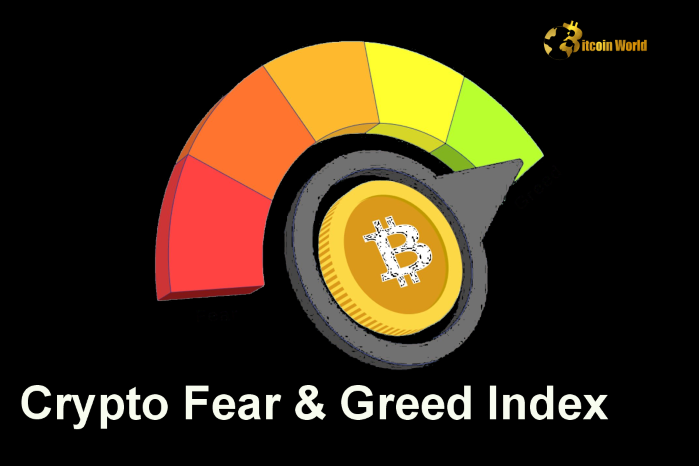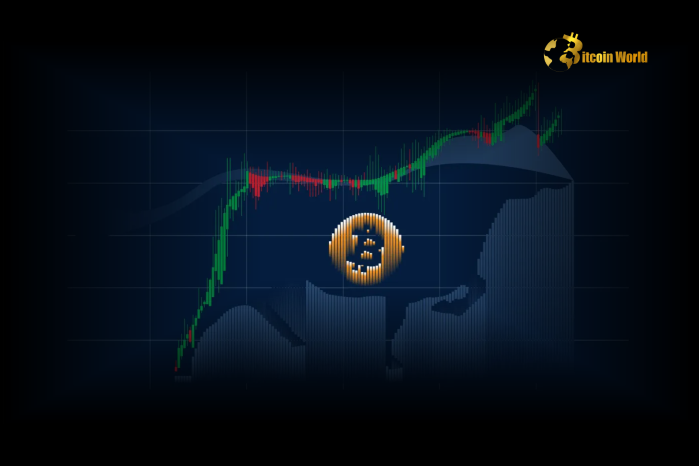
The Crypto Fear & Greed Index dropped eight points to 68 on February 1 , moving from the “Extreme Greed” zone to “Greed” , according to Alternative.me . This shift suggests a cooling of market sentiment , as traders show reduced risk appetite following recent bullish momentum . Understanding the Crypto Fear & Greed Index The Crypto Fear & Greed Index measures market sentiment on a scale of 0 to 100 , with: 0 = Extreme Fear (high uncertainty, sell-offs) 50 = Neutral (balanced sentiment) 100 = Extreme Greed (high speculation, FOMO-driven buying) Since the index now sits at 68 (Greed) , the market remains bullish but with less speculative enthusiasm than before . Why Did the Crypto Fear & Greed Index Drop? Key Factors Behind the Sentiment Shift: Profit-Taking After Recent Gains – Investors may be securing profits after strong market rallies. Bitcoin & Altcoin Volatility Increase – Price swings have created caution among traders . ETF Inflows Stabilizing – Slower capital inflows into spot Bitcoin ETFs may signal less aggressive accumulation . Macroeconomic Uncertainty – Investors are watching the Fed’s next moves on interest rates and inflation . While sentiment remains positive , the decline from Extreme Greed suggests traders are becoming more cautious . Is the Market Cooling Off or Preparing for Another Surge? Bullish Scenario: If Bitcoin and major altcoins maintain strong support levels , sentiment could recover quickly . Bearish Scenario: If fear increases and selling pressure rises , the index may decline further toward Neutral . Institutional Buying Trend: If ETF inflows pick up again, confidence in the market could strengthen . With the Crypto Fear & Greed Index still in Greed , the market remains optimistic, but short-term uncertainty persists . FAQs What is the Crypto Fear & Greed Index? A sentiment indicator measuring market emotions from 0 (Extreme Fear) to 100 (Extreme Greed) . Why did the index drop to 68? Weaker market momentum, profit-taking, and increased price volatility contributed to the decline. Is a drop from Extreme Greed a bad sign? Not necessarily. A slight cooldown can prevent speculative bubbles and create healthier market conditions . Could the index rise again soon? Yes. If Bitcoin and altcoins regain strong momentum, sentiment could shift back toward Extreme Greed . Should traders be cautious? Yes. While the market remains bullish , reduced enthusiasm suggests potential short-term corrections . Conclusion The Crypto Fear & Greed Index fell to 68 , signaling a slight cooldown in market sentiment as traders become less aggressive but still optimistic . While the market remains in Greed territory , investors should monitor price movements, ETF inflows, and macroeconomic trends for further guidance. As crypto markets evolve , sentiment could shift quickly, offering new opportunities or risks . To learn more about the innovative startups shaping the future of the crypto industry, explore our article on latest news , where we delve into the most promising ventures and their potential to disrupt traditional industries.
Bitcoin World
You can visit the page to read the article.
Source: Bitcoin World
Disclaimer: The opinion expressed here is not investment advice – it is provided for informational purposes only. It does not necessarily reflect the opinion of BitMaden. Every investment and all trading involves risk, so you should always perform your own research prior to making decisions. We do not recommend investing money you cannot afford to lose.
Bitcoin Analysts Warn of a $95K ‘Bear Trap’ Ahead Despite $100,000 Monthly Close

Uncertainty has hit the Bitcoin (BTC) market despite closing January above the psychological $100,000 level. However, the leading digital asset has slid below this notable level just a day before the first business day in February. Is Inflation Fears Behind Bitcoin’s Dip? Market observers attribute the dip to inflation worries that have swept the broader market. Most market participants fear that President Donald Trump’s imposition of tariffs on the trio of Mexico, Canada, and China could trigger inflation. Others see the dip as part of a wider market correction, which could plunge BTC to $95,000. Ryan Lee, chief analyst at Bitget Research, however, identifies $95,000 as a crucial support level. Lee stressed the need for investors to monitor the broader financial space as it concerns federal policy expectations. He also expects market sentiments to play a role in determining the next move for Bitcoin. Bear Trap or Market Correction? Interestingly, Lee believes Bitcoin’s price might react to macroeconomic factors. Notably, the U.S. labor report could shape the coin’s price outlook for February. The Bureau of Labor Statistics in the U.S will release its market report by Friday, February 7. The price of Bitcoin could regain higher levels if the market report data paints the picture of a “slow economy.” This might spur investors to consider accumulating Bitcoin as an alternative, and the demand could push the price up. Meanwhile, Sensei, another analyst on X, in a post , described the current Bitcoin dip as a “huge bear trap.” He noted that BTC traders anticipating further decline might get caught unaware of Bitcoin’s rebound. Huge Bear Trap. Be ready. pic.twitter.com/MDkqMrDNsG — Sensei (@SenseiBR_btc) February 2, 2025 Sensei calls on traders to exercise caution, particularly those trading on short positions. If his projections turn out accurate, Bitcoin might record a sharp recovery. Analysts Predict Bitcoin to $180,000 As of this writing, Bitcoin is changing hands at $99,250.69, representing a 2.57% decline in the past 24 hours. The coin hit a low of $98,137.60 in earlier trading but has seen a mild 3.34% uptick to $42.78 billion in trading volume. Analysts have projected that Bitcoin could climb as high as $180,000 in 2025 as they anticipate the coin to have a bullish year. The post Bitcoin Analysts Warn of a $95K ‘Bear Trap’ Ahead Despite $100,000 Monthly Close appeared first on TheCoinrise.com . Bitcoin World

U.S. Spot Ethereum ETFs See $27.8M in Net Outflows on January 31
U.S. spot Ethereum ETFs recorded $27.8 million in net outflows on January 31 , marking the second consecutive trading day of investor withdrawals , according to Farside Investors . While BlackRock’s ETHA led with strong inflows , Grayscale’s ETHE saw significant outflows , reflecting mixed market sentiment toward Ethereum investment products. Breakdown of Ethereum ETF Flows on January 31 Top Ethereum ETF Inflows: BlackRock’s ETHA – $57.3 million VanEck’s ETHV – $2.4 million Ethereum ETF Outflows: Grayscale’s ETHE – $31.9 million Other Ethereum ETFs reported no significant changes in inflows or outflows . Why Are Ethereum ETFs Seeing Outflows? Profit-Taking by Investors – After strong inflows earlier in January , some investors are likely locking in gains . Rotation into Other Assets – Traders may be shifting focus to Bitcoin ETFs or other alternative assets . Grayscale’s Outflows Continue – As seen with Bitcoin ETFs , Grayscale’s high-fee structure may be driving capital exits . Despite outflows in Grayscale’s ETHE , institutional demand remains steady , with BlackRock’s ETHA continuing to attract capital . What’s Next for Ethereum ETFs? Potential Market Rebound? – If Ethereum prices stabilize, ETF inflows may resume . More Institutional Accumulation? – BlackRock’s strong inflows suggest continued interest from large investors . Regulatory Developments to Watch – Further SEC approvals or policy changes could impact future flows . While Ethereum ETFs faced outflows on January 31 , the overall market outlook remains positive , especially as institutional adoption continues . FAQs How much did U.S. Ethereum ETFs lose on January 31? A total net outflow of $27.8 million , led by Grayscale’s ETHE ($31.9M outflow) . Which Ethereum ETF had the highest inflows? BlackRock’s ETHA recorded $57.3 million in inflows , leading the market. Why is Grayscale’s ETHE losing capital? High fees and investors rotating into lower-cost ETFs may be driving outflows. Are Ethereum ETFs still attracting institutional investors? Yes. BlackRock’s ETHA continues to see strong inflows , signaling institutional interest. Will Ethereum ETF flows recover? It depends on market sentiment, price stability, and institutional investment trends . Conclusion U.S. spot Ethereum ETFs saw $27.8 million in net outflows on January 31 , with Grayscale’s ETHE facing significant withdrawals while BlackRock’s ETHA gained traction . While short-term profit-taking may be influencing flows , institutional demand remains strong , suggesting that Ethereum ETF adoption is still growing . Investors should monitor upcoming ETF trends and Ethereum’s market performance for further insights into institutional sentiment . To learn more about the innovative startups shaping the future of the crypto industry, explore our article on latest news , where we delve into the most promising ventures and their potential to disrupt traditional industries. Bitcoin World











